Woodpeckers in Louisiana play a vital role in maintaining the health of local ecosystems, adapting seamlessly to diverse habitats ranging from swamps to forests. This exploration sheds light on two prominent woodpecker species in Louisiana—the Pileated Woodpecker and Red-cockaded Woodpecker—unveiling their behaviors and ecological significance.
Woodpeckers, renowned for their tree-drilling activities, significantly impact forest health by creating nesting sites and controlling insect populations. Despite facing challenges such as habitat loss, these birds remain indispensable contributors to the ecological balance.
List of Woodpeckers of Louisiana
Red-Headed Woodpecker
Scientific Name: Melanerpes erythrocephalus
- Life Span: 8–10 years
- Size: 19 to 25 cm
- Weight: 56 to 97 g
- Wingspan: 35 to 43 cm
- Status: Least Concern
- State Status: Breeding and Uncommon
The Red-Headed Woodpecker, distinguished by its vibrant redhead and black-white plumage, stands out easily. Thriving on insects, fruits, and nuts, their breeding season involves impressive drumming displays. Conservation efforts include creating nest cavities and preserving dead trees.
During the breeding season in May, the male showcases impressive drumming on dead trees to court potential mates. Once a pair forms, they collaboratively carve nest cavities in decaying or dead trees. While the female incubates the eggs, the male diligently provides food for her and the chicks.
Feeding on insects, nuts, and fruits, Red-Headed Woodpeckers are versatile eaters, occasionally raiding smaller bird species’ nests during challenging times. Despite being categorized as “Least Concern,” their population has decreased due to habitat loss and the removal of dead trees for nesting.
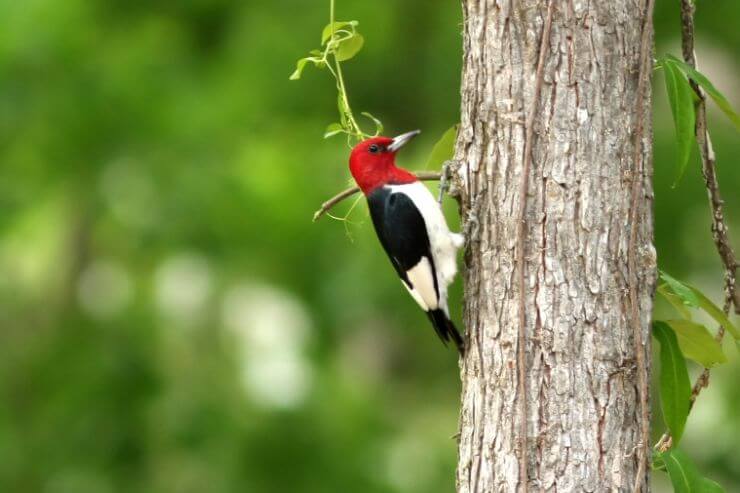
Pileated Woodpecker
Scientific Name: Dryocopus pileatus
- Life Span: 6–10 years
- Size: 16–19 inches
- Weight: 10–12 oz
- Wingspan: 26–30 inches
- Status: Least Concern
- State Status: Breeding and Common
The Pileated Woodpecker, found in mature forests, is renowned for its drumming and excavation skills. Adaptable to artificial nests, it maintains an omnivorous diet. Conservation focuses on habitat preservation and suitable nesting sites.
The Pileated Woodpecker is monogamous, fiercely defending its territory through vocalizations and displays. Known for exceptional excavation skills, it creates large cavities in decaying trees for nesting and food storage. Adaptable to artificial nest boxes, it thrives on an omnivorous diet, primarily consisting of insects.
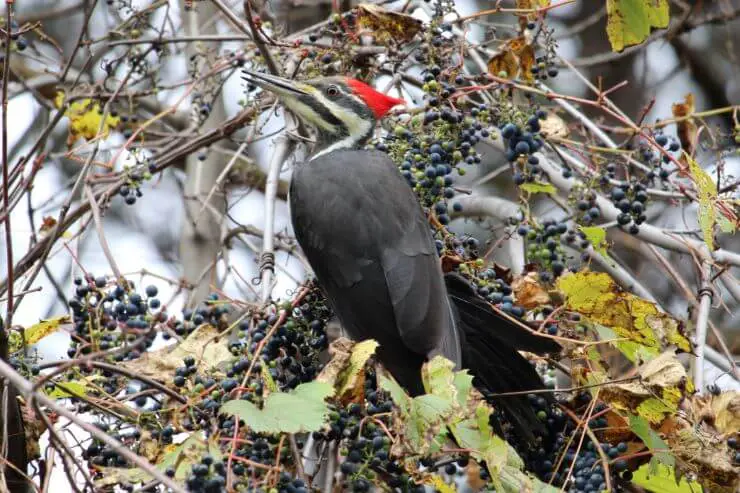
Yellow-Bellied Sapsucker
Scientific Name: Melanerpes flavifrons
- Life Span: 5–8 years
- Size: 8–10 inches
- Weight: 2.5 oz
- Wingspan: 14–16 inches
- Status: Least Concern
- State Status: Migratory and Common
Known for its distinctive yellow belly, the Yellow-Bellied Sapsucker carves nests collaboratively. Relying on tree sap, insects, and fruits, conservation involves preserving mature forested areas.
The Yellow-Bellied Sapsucker, with its eye-catching black and white features and distinctive yellow belly, is a woodpecker species renowned for its unique nesting habits. Collaboratively, male and female birds use their beaks to carve holes into trees or wooden structures, lining the nests with soft materials like wood chips or grass.
These sapsuckers rely on tree sap, insects, fruits, and occasionally small birds for sustenance, favoring coniferous trees that attract their preferred food sources. While currently classified as “Least Concern” by the IUCN, some regions have witnessed population declines due to habitat loss and degradation.
Conservation efforts focus on safeguarding mature forested areas with a mix of deciduous and coniferous trees, where the Yellow-Bellied Sapsuckers can thrive.
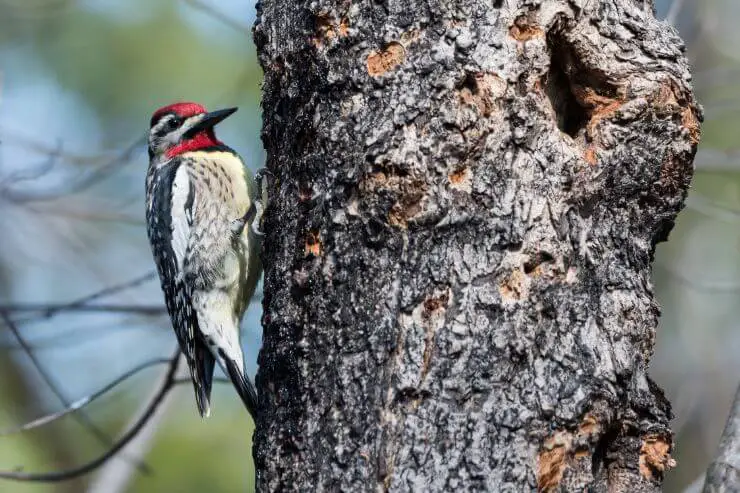
Downy Woodpecker
Scientific Name: Picoides pubescens
- Life Span: 2–5 years
- Size: 6–7 inches
- Weight: 1 oz
- Wingspan: 13 inches
- Status: Least Concern
- State Status: Breeding and Very Common
The Downy Woodpecker, recognized by its black and white head pattern, contributes to the forest ecosystem by controlling insects. Conservation efforts focus on preserving habitats and sustainable forestry practices.
The Downy Woodpecker’s remarkable skill in creating nesting cavities is well-known. Both male and female woodpeckers collaborate, using their sturdy beaks to chisel away at wood until they form a suitable site. The nest cavity is thoughtfully lined with soft materials like wood chips for the chicks’ comfort.
This bird’s diet primarily consists of insects, such as beetles, ants, and caterpillars, which it finds by pecking at tree bark. It also enjoys sipping sap from trees and shrubs, achieved by puncturing holes in the bark, and indulges in fruits, nuts, and seeds from various plants like palmetto, elderberry, and pine cones.
Despite experiencing declines in some regions due to habitat loss and degradation, the Downy Woodpecker remains classified as “Least Concern” by the IUCN. Conservation efforts focus on preserving and rehabilitating critical habitats, managing and removing invasive species, and promoting sustainable forestry practices to safeguard these species and their homes.
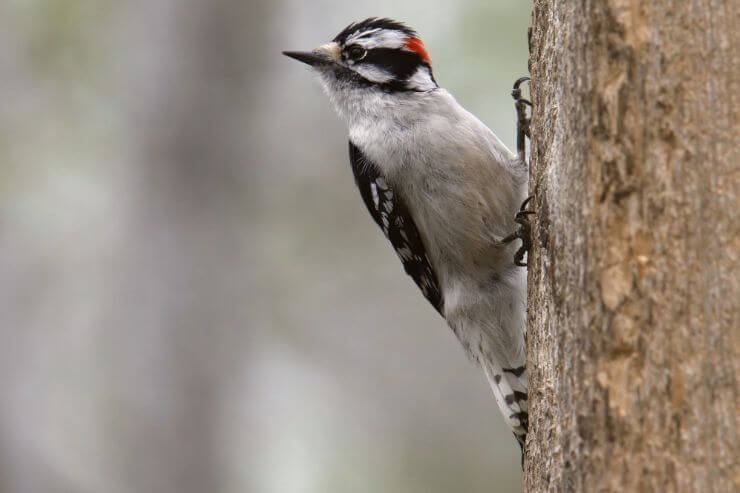
Understanding these woodpeckers enhances appreciation for their role in Louisiana’s natural balance. Conservation measures, including habitat preservation, nest creation, and sustainable practices, are crucial for their well-being.
Hairy Woodpecker
- Scientific name: Picoides villosus
- Life span: 5-10 years
- Size: 7-10 inches
- Weight: 1.5 oz
- Wingspan: 16-20 inches
- Status: Least concern
- State status: Breeding and common
The Hairy Woodpecker, a native of Texas, is distinguished by its black and white plumage, a long chisel-shaped bill, and a distinct personality. Thriving in various habitats, from Alaskan woodlands to Mexican residential areas, this adaptable bird is a frequent visitor to bird feeders.
Known for its exceptional tree-drumming abilities and skill in extracting insects from tree trunks, the Hairy Woodpecker is a favorite among bird enthusiasts and backyard birdwatchers. Both males and females actively contribute to nest excavation, creating cavities in trees or wooden structures using their beaks. The nest interiors are furnished with soft materials like wood chips and occasionally human-made items.
The Hairy Woodpecker’s diet primarily consists of insects like beetles, ants, and caterpillars, foraged by pecking at tree bark and wooden surfaces. They also consume sap from trees, and shrubs, as well as various fruits, nuts, and seeds. While the species is widespread, some populations face declines due to habitat loss, leading to conservation efforts classifying it as “Least Concern.”
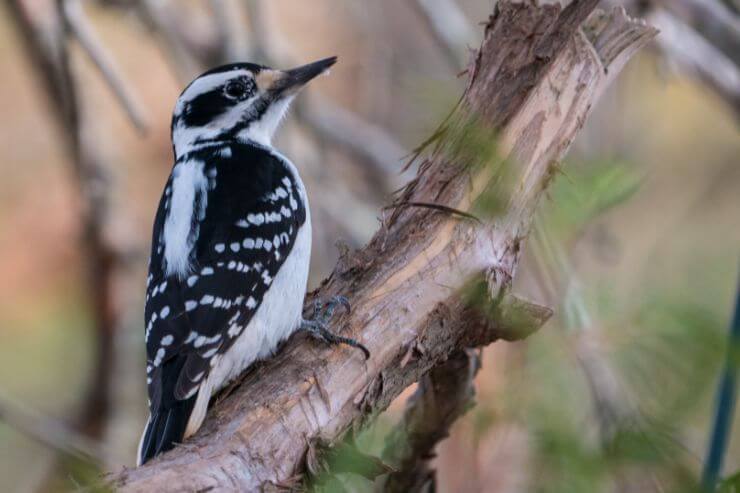
Northern Flicker
- Scientific name: Colaptes auratus
- Life span: 5-8 years
- Size: 8-10 inches
- Weight: 2.5 oz
- Wingspan: 14-16 inches
- Status: Least concern
- State status: Breeding and common
The substantial Northern Flicker stands out with its distinct appearance, ranging widely across North America. Found in diverse habitats such as forests, parks, and suburban areas, this bird is cherished for its captivating patterns and lively behavior.
With a red nape patch and a long, straight beak, the Northern Flicker enjoys a varied diet of insects, seeds, and fruits. Known for intricate nesting habits, it constructs cavities in trees or structures, adapting to human-made elements. The species communicates and attracts mates by tapping its beak rhythmically.
Classified as “Least Concern” by the IUCN, the Northern Flicker has a population between 10 and 20 million. Despite challenges like habitat loss, it has adapted to human-altered environments, including urban settings.
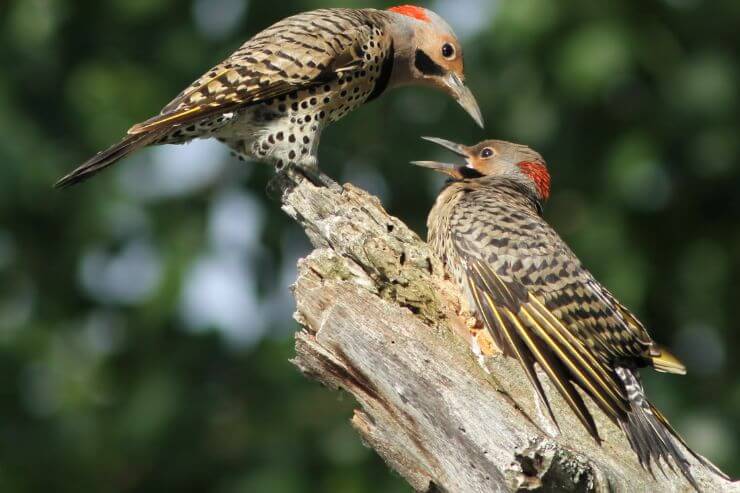
Red-Cockaded Woodpecker
- Scientific name: Picoides borealis
- Life span: 5 to 9 years
- Size: 7.1 to 8.3 inches (18 to 21 cm)
- Weight: 1.5 to 1.8 ounces (42 to 51 grams)
- Wingspan: 14 to 16.5 inches (36 to 42 cm)
- Status: Least concern
- State status: Breeding and rare
Meet the Red-cockaded Woodpecker, a captivating species found in the southeastern United States. Featuring striking black and white plumage with a small red streak on males’ heads, these woodpeckers are unique for excavating cavities exclusively in living pine trees.
These crafty woodpeckers chisel cavities into living pine trees, creating cozy homes for their families. With meticulous care, they maintain their homes, ensuring safe abodes for chicks. Their diverse diet includes insects, fruits, and tree sap. Conservation efforts involve prescribed fires to create a suitable natural environment.
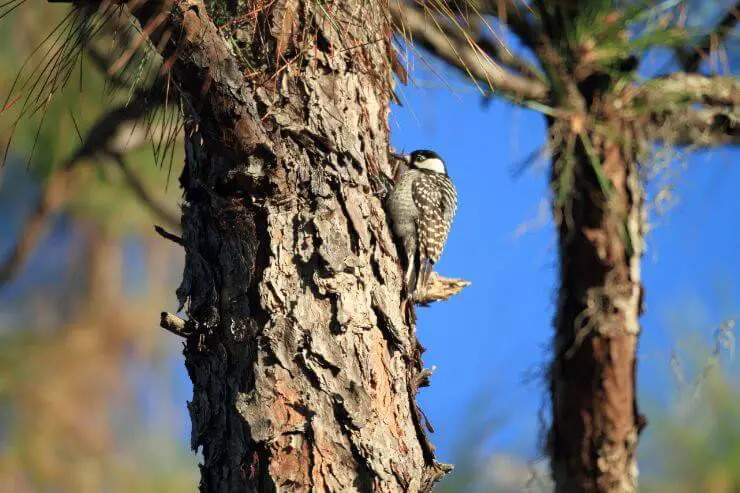
Red-Bellied Woodpecker
- Scientific name: Melanerpes carolinus
- Life span: Up to 15 years
- Size: 9 to 10.6 inches (23 to 27 cm)
- Weight: 2 to 3.2 ounces (57 to 91 grams)
- Wingspan: 13 to 16.5 inches (33 to 42 cm)
- Status: Least concern
- State status: Breeding and very common
Meet the Red-bellied Woodpecker, a lively and colorful bird found in the woodlands of eastern North America, spanning from Florida to southern Canada. Despite its name, the red blush on its belly is just a subtle touch.
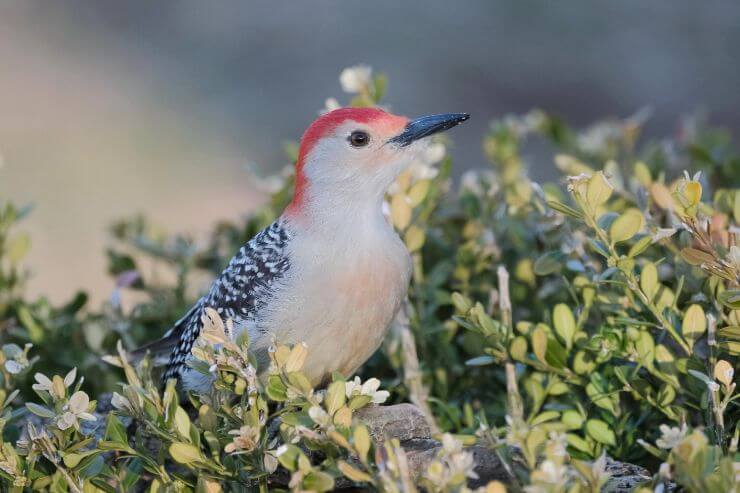
These woodpeckers are skilled architects, crafting cozy nests in tree hollows with precision. Their nests, lined with soft materials, provide a snug haven for their chicks.
Red-bellied Woodpeckers are true forest foodies, relishing in a variety of insects, juicy fruits, and scrumptious seeds. Their agile tongues expertly extract hidden treats from tree crevices.
Throughout history, these woodpeckers have flourished in the lush woodlands of eastern North America. However, human development has posed challenges to their habitats. Conservationists are dedicated to protecting these dynamic birds, establishing protected areas, and educating communities for harmonious coexistence.
Thanks to these efforts, the vibrant presence of the Red-bellied Woodpecker continues to enhance the forest with its charming existence.
Where to Spot Woodpeckers in Louisiana
For bird enthusiasts seeking woodpeckers in Louisiana, the state offers rewarding experiences with these vibrant birds. While they can be found throughout the state, specific regions and techniques can enhance your chances of spotting them.
Here are four noteworthy areas to explore and tips on finding woodpeckers in Louisiana:
- Atchafalaya Basin: Explore this vast swamp, a haven for woodpeckers. Keep an eye out for the Pileated Woodpecker in cypress and tupelo trees along waterways. Binoculars or a telephoto lens can aid in observing them from a distance.
- Kisatchie National Forest: This expansive forest in central Louisiana is home to various woodpecker species, including the endangered Red-cockaded Woodpecker. Join guided tours organized by local conservation groups to gain insights into these birds and their habitats.
- Toledo Bend Reservoir: Head to this scenic area along the Louisiana-Texas border to spot the Red-bellied Woodpecker and Downy Woodpecker. Wooded areas and campgrounds, especially those with feeders, are good locations.
- Tickfaw State Park: Located in the southeastern part of the state, this park boasts diverse birdlife. Explore the park’s trails to encounter the Northern Flicker and Yellow-bellied Sapsucker, commonly found in deciduous forests.
When searching for woodpeckers, patience and quiet observation are key. Bring along field guides or birding apps for identification, and consider joining local birding groups or tours for expert guidance.
Respect the natural habitat of these birds and savor the serene beauty of Louisiana’s landscapes while observing these fascinating woodpeckers.
Final Thoughts
From the Atchafalaya Basin to the Toledo Bend Reservoir, woodpeckers find refuge in diverse habitats across Louisiana. By respecting and appreciating their unique roles, we can ensure that woodpeckers continue to contribute to Louisiana’s biodiversity, fostering a deeper connection with the state’s natural treasures.

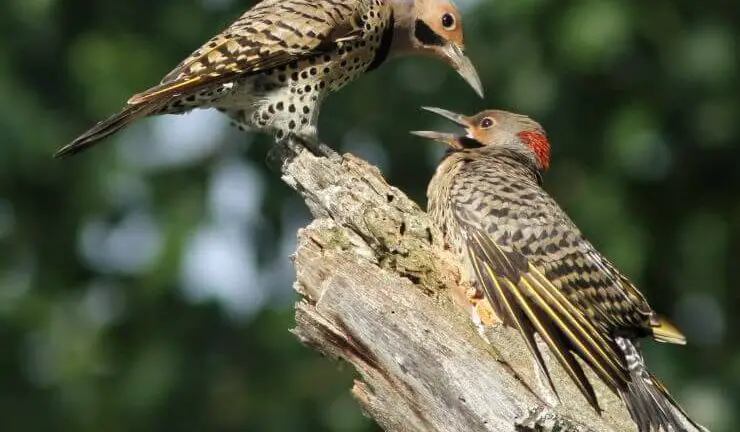
![10 Beautiful Red Birds in Louisiana [Images + IDs]](https://birdsology.com/wp-content/uploads/2023/03/45-13-600x400.jpg)
![14 Beautiful hummingbirds in Louisiana [Pictures + IDs]](https://birdsology.com/wp-content/uploads/2023/03/9405731962_c9d7651c12_c-600x400.jpg)
![5 Types of Doves in Louisiana [Images + IDs]](https://birdsology.com/wp-content/uploads/2023/09/51966837857_e62c6fbc37_b-600x400.jpg)
![8 Types of Owls in Louisiana [Images + Ids]](https://birdsology.com/wp-content/uploads/2023/03/44723111885_a464d2a6a0_b-600x400.jpg)